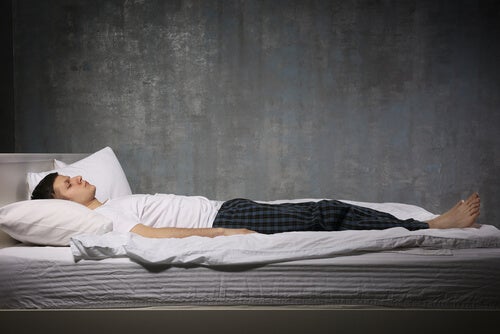MR Therapy for Sleep Paralysis

MR therapy helps treat sleep paralysis (SP). This sleep disorder involves a state of muscular paralysis. It can either happen when you first go to sleep or right after waking up. It comes from a problem in the brain mechanisms that regulate the REM-wake cycle.
When you experience sleep paralysis, you’re awake and can feel things but can’t move any part of your body. This situation obviously leads to a ton of anxiety, fear, and potentially hypnagogic and hypnopompic hallucinations.
It falls into the category of primary sleep disorders and isn’t a product of mental illness, substance abuse, or any other medical issue. The Diagnostic and Statistical Manual of Mental Disorders (DSM-IV, 1994) calls it a type of parasomnia. In other words, it affects the quality of your sleep and how much sleep you get.
It always happens between REM sleep and waking up. According to the International Classification of Sleep Disorders, it can be a chronic issue or only happen once or twice. This also means that you can develop it from completely circumstantial factors.

The Main Characteristics of Sleep Paralysis
Your brain activity is almost exactly the same during the REM stage than when you’re awake. This is the stage when you have your most complex, emotional dreams. Due to evolution, some of your muscles are paralyzed during this stage. But changes in your sleep habits can alter this process of turning your muscles on and off.
What Physiological Processes Are Involved?
Your body releases GABA neurotransmitters and glycine to relax your body’s muscles. From there, they inhibit the motor neurons in your spinal cord.
But any problem in the process of waking up can cause you to wake up before you’ve regained your ability to move and react. Your limbic (emotional) system then processes and interprets the situation as you’re experiencing it.
The Flight Response
Once all this happens, your amygdala starts to respond based on these emotions. Due to the fact that you’re in the dark and unable to move, your brain tends to assume extreme danger.
Of course, that means you’ll probably feel afraid or terrified. This intense emotional experience can cause changes in the way you perceive things. That’s where the visual, tactile, and auditory hallucinations start to manifest.
Feeling that Something Else Is in the Room
It’s extremely common with sleep paralysis for you to feel like something is watching you. The inability to move, combined with your anxiety and the boosted imagination from your sleep state, make you expect to see something around you.
Your brain is on extra-high alert for threats but that doesn’t mean they’re actually there. This is why it’s so common for people with sleep paralysis to feel like there’s someone or something close to them.
MR Therapy for Sleep Paralysis: Unmasking the Ghost
Not many researchers have tried to find a specific psychological treatment for this condition. One of them is Baland Jalal, from the University of Cambridge’s psychology department. He proposed using MR therapy (muscle relaxation) for sleep paralysis in 2016.
His argument is that the fear, anxiety, and distress create a feedback loop that only worsen the episodes and hallucinations. He developed a potential treatment model with these pillars:
- A re-evaluation of the meaning of the episode. Recognizing that it’s harmless and temporary (you won’t die or be paralyzed forever). It also involves recognizing that the hallucinations mostly happen because you were in REM sleep beforehand. Recognizing these things can help people stay calm when it happens.
- Psychological and emotional distance. You have to understand that feeling worried and afraid just worsen the episodes. This also means accepting that it’s not a paranormal event. It’s just a bodily response.
- Meditation and focusing your attention inwards. It’s vital to work on meditation to treat the problem successfully. The mechanisms you use to meditate are about controlling your attention to ignore your hallucinations.
- Muscle relaxation. The physical symptoms such as paralysis and an inability to breathe voluntarily are easier to grapple with if you ignore them. Otherwise, they’ll just get in the middle of you trying to focus on your inner world. You absolutely have to stay calm and relax.

The Importance of Practice
You have to practice if you want MR therapy to help you treat sleep paralysis. First, you need to replicate the position you’re in when the paralysis happens). From there, you can go through each step.
It’s extremely overwhelming when it happens, and practice will give you a chance to try these techniques out without the stress of the real thing.
The goal is to make yourself ready to respond passively and think of positive things whenever the scary sensations manifest.
Relaxation
According to specialists such as Dr. Ramachandran, the fact that your limbs and motor system aren’t synchronized alters your sensory processing. Thus, when you want to run away, and your mind starts to try, but your body won’t do anything, it alters your entire sense of self-perception.
This is why you might feel like you’re floating, have out-of-body experiences, and see scary things. But if you try to relax instead of run away, you can prevent those perception alterations.
Treatment
This is basically a cognitive-behavioral treatment. Its goal is to change your behavior and keep you from entering a negative feedback loop. We should also mention that whether or not the treatment works depends a lot on your attitude.
Another big thing it depends on is how much control you have over your attention. Being able to concentrate and interpret your sensations plays a big part. This model says that you have to completely change your focus. That’s where relaxation comes in. You move away from negative external stimuli to neutral or positive internal ones.
One last point: as unusual as the experience might seem, it’s not actually that serious. The episodes themselves aren’t as problematic as the mental toll they can take. If you suffer from chronic sleep paralysis, you might start to experience a lot of anxiety. As always, it’s best to see a professional therapist if you’re having a problem with this.
This text is provided for informational purposes only and does not replace consultation with a professional. If in doubt, consult your specialist.








